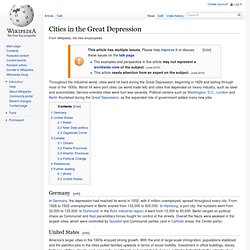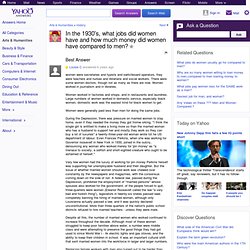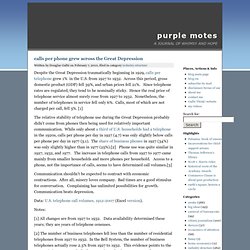

The Vault - TrueBlood-Online.com. Cities in the Great Depression. Throughout the industrial world, cities were hit hard during the Great Depression, beginning in 1929 and lasting through most of the 1930s.

Worst hit were port cities (as world trade fell) and cities that depended on heavy industry, such as steel and automobiles. Service-oriented cities were hurt less severely. Political centers such as Washington, D.C., London and Berlin flourished during the Great Depression, as the expanded role of government added many new jobs. Germany[edit] In Germany, the depression had reached its worst in 1932, with 6 million unemployed, spread throughout every city.
United States[edit] America's larger cities in the 1920s enjoyed strong growth. The Depression's damage to large cities, suburbs, towns and rural areas varied according to the economic base. Second came the general downturn in industry, especially heavy manufacturing. Although suburbia stopped growing, it did not suffer nearly as much as the central cities. Relief[edit] New Deal politics[edit] Maryland During the Great Depression - Enoch Pratt Free Library. History 1901-1940. Telephone History The New Century 1901 -- 1940 Click on photo to enlarge The turn of the century was a tough time for the Bell Companies.

Rapid expansion led to poor service and the public was becoming more apathetic with the big monopoly. As service expanded across the country, the company also had a dilemma in that technology could not keep up with the incredible growth. The independent companies were at the heels of the Bell Companies and something had to change. In the 1930's, what jobs did women have and how much money did women have compared to men.
Women were secretaries and typists and switchboard operators, they were teachers and nurses and librarians and social workers.

There were some women doctors, though not as many as there are now. Women worked in journalism and in libraries. Women worked in factories and shops, and in restaurants and laundries. Large numbers of women worked in domestic service, especially black women, domestic work was the easiest kind for black women to get. Women were generally paid less than men for doing the same jobs. During the Depression, there was pressure on married women to stay home, even if they needed the money they got fromw orking. Very few women had the luxury of working for pin money Perkins herself was supporting her unemployable husband and their daughter. Despite all this, the number of married women who worked continued to increase throughout the decade. 'America's Women: 400 years of dolls, drudges, helpmates and heroines' by Gail collins.
Calls per phone grew across the Great Depression. Despite the Great Depression traumatically beginning in 1929, calls per telephone grew 1% in the U.S. from 1927 to 1932.

Across this period, gross domestic product (GDP) fell 39%, and urban prices fell 21%. Since telephone rates are regulated, they tend to be nominally sticky. Hence the real price of telephone service almost surely rose from 1927 to 1932.
Pearltrees tips.